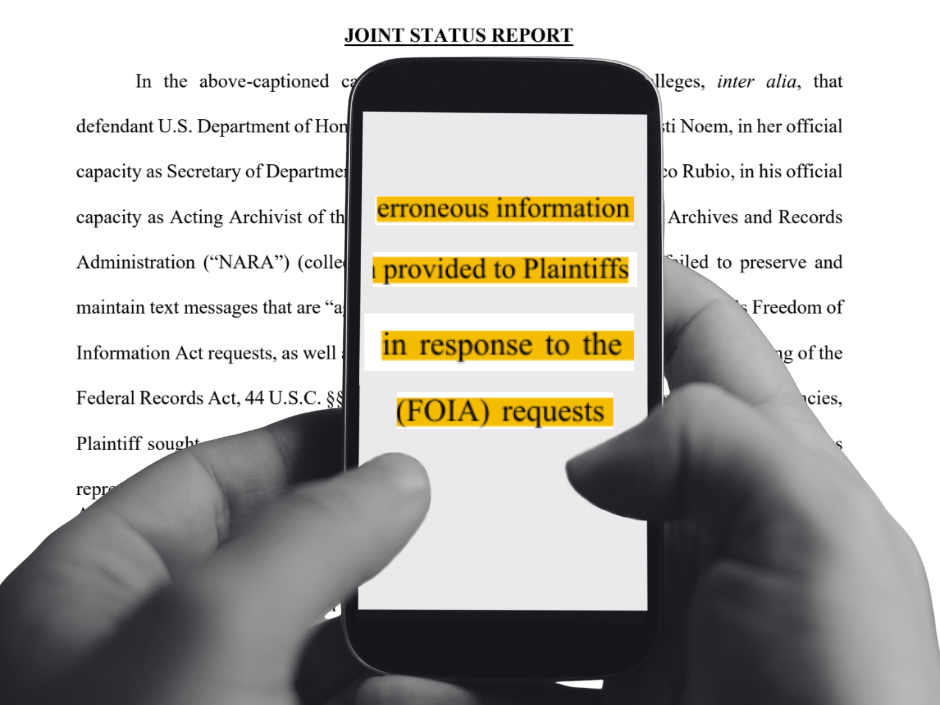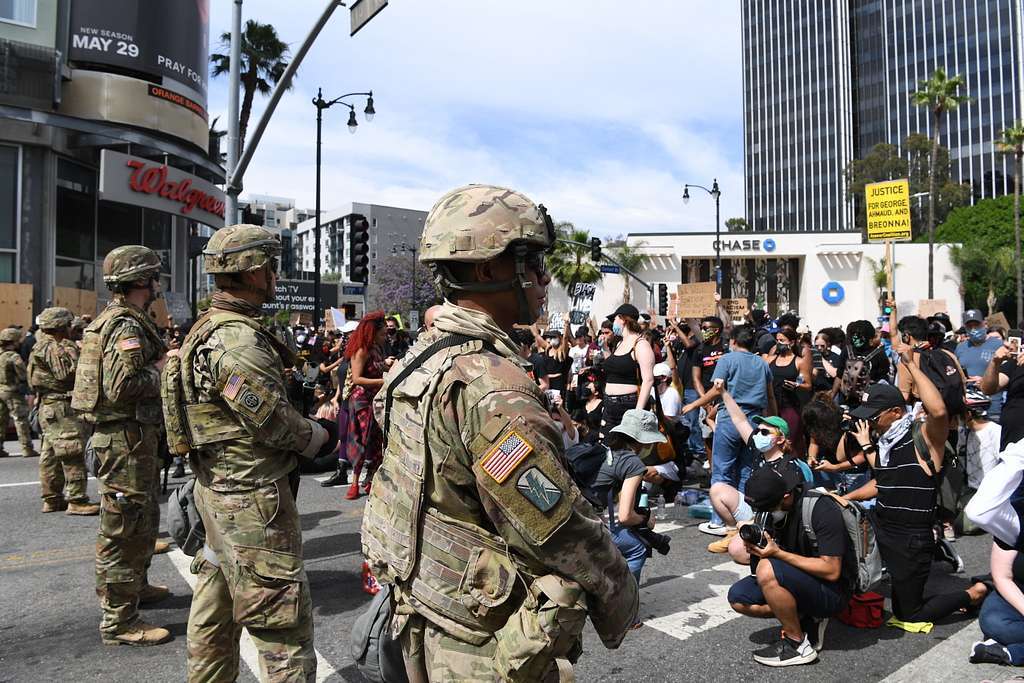
The Militarized Response to Protests of Immigration Raids in Los Angeles
This stunning abuse of power violates American’s right to peaceful protest and demonstrates Trump’s increasing willingness to weaponize all facets of the government to chill dissent. American Oversight is using public records requests and litigation to investigate the military’s involvement in immigration enforcement and the authoritarian response to the protests.

When President Donald Trump ordered thousands of federal troops to suppress protests in Los Angeles — despite the objections of California Gov. Gavin Newsom — it was a stunning abuse of power, made under flimsy legal pretense, that demonstrated his willingness to weaponize all parts of the government to chill dissent and serve his draconian anti-immigrant priorities.
The deployment of armed soldiers to quash protests against the administration’s inhumane and legally dubious immigration policies is a dangerous escalation of the Trump administration’s authoritarian practices. Using the military as a political weapon is an alarming assault on our democracy that if left unchecked will be easily replicated across the country and against the most vulnerable in our society. To counter the president’s efforts to consolidate power and mold his office into that of a dictator, the people must be able to see into the government’s machinations as it seeks to prevent Americans from exercising their First Amendment rights. Using public records requests and litigation, American Oversight is investigating the military’s involvement in immigration enforcement and the administration’s response to the protests.
Background
Trump has made harsh and dehumanizing immigration policies a cornerstone of his second administration, arresting undocumented immigrants, and in some cases legal residents, with the aim of deporting record numbers of people. But in late May, Trump reportedly became upset that the number of daily deportations were not high enough. White House Deputy Chief of Staff Stephen Miller instructed Immigration and Customs Enforcement (ICE) to step up arrests, including by targeting day laborers at stores like Home Depots. “We’re going to flood the zone,” Thomas Homan, Trump’s border czar bragged to reporters, describing the administration’s plan to raid workplaces.
Protests in Los Angeles began with a demonstration against one such ICE raid. On Friday, June 6, ICE agents searched the city’s garment district for workers suspected of being undocumented. As agents made their way through the neighborhood, a small group of protesters threw eggs and chanted before police dispersed them with pepper spray and rubber bullets. Labor leader David Huerta, president of the Service Employees International Union of California, was arrested and charged with conspiracy to impede an officer — a felony that could result in a prison sentence of six years — for allegedly banging on a gate and standing in front of a law enforcement van.
The next day, a larger protest emerged in Paramount, a town south of Los Angeles, after rumors spread that ICE was going to raid a Home Depot store. Tensions between the crowd and police increased throughout the day, with officers shooting tear gas. Despite local and state authorities stating that the situation was under control, that evening Trump ordered 2,000 National Guard soldiers to L.A. over the objections of Newsom and Mayor Karen Bass. This was the first time a president has activated a state’s National Guard without the request of a governor since 1965. Trump’s order to send in National Guard troops coincided with a memorandum that reportedly “authorizes” the deployment using 10 U.S.C. § 12406, which permits the president to call federalized troops into service in situations of invasion or rebellion or where regular forces are insufficient to execute the law.
The National Guard deployment only inflamed tensions as thousands showed up that Sunday to protest. The majority of the demonstrations remained peaceful, with incidents of violence limited to just a few streets. That evening, the city declared the entire downtown area an unlawful assembly zone that night, with most crowds having dispersed by midnight.
On Monday, with widespread reports indicating that the city was relatively calm, California filed a lawsuit against the administration, claiming the deployment was an illegal and unconstitutional incursion on state authority. But in a show of autocratic force, Trump — who earlier that day had stated, “I think we have it very well under control” — deployed 700 Marines and another 2,000 National Guard members to the city. Experts estimated the move would cost taxpayers $134 million, while protests spread to other cities in response to the clear effort to intensify both political and physical clashes.
The Stakes for Our Democracy
The deployment of federal troops to suppress protests demonstrated Trump’s willingness to manufacture “crises” as a way to expand his presidential powers. While Trump’s memo cited a law that permits the president to federalize troops in situations of invasion or rebellion, clashes with police were confined to a small area and did not constitute a rebellion or invasion. “To put it bluntly, there is no invasion or rebellion in Los Angeles; there is civil unrest that is no different from episodes that regularly occur in communities throughout the country, and that is capable of being contained by state and local authorities working together,” the state of California noted in its lawsuit. Trump’s memo federalizing the National Guard troops was not specific to Los Angeles, leading to concerns that he may rely on it to justify the presence of troops in any situation in which there is even minimal resistance to actions by ICE or other federal agencies.
Trump has also indicated he is considering invoking the Insurrection Act to grant him even more emergency powers for using military force against civilians. Indeed, given Project 2025’s calls for increased federal military authority, Trump’s deployment of National Guard troops to Los Angeles would seem to be an opening salvo in a coordinated national strategy — and not an isolated incident. The consequences of such a gross misuse of authority are catastrophic for a healthy democracy: If all dissent is met with militaristic suppression, the grossest violations of human rights and corruption laws cannot be checked.
The incursion into state power also potentially violates long-established laws designed to prevent an authoritarian takeover by the federal government, such as the Posse Comitatus Act, which prohibits active-duty military from conducting law enforcement activities unless expressly authorized by another law. The act was born of the founders’ fears of a tyrannical president misusing the country’s military against its people, and reflects the deep-rooted American practice of reserving law enforcement to the states. The fears are justified: Trump has communicated in no uncertain terms his disdain for democratic disagreement and peaceful protest, having warned that anyone who protests the June 14 military parade in Washington, D.C., will be met with “very heavy force.”
How We’re Fighting Back
Americans have a right to know who authorized this alarming deployment, what rationale was offered, and not just whether the government crossed a line — but by how much that line has been obliterated.
On June 10, American Oversight filed suit against the administration for failing to release records regarding the military’s involvement in immigration enforcement. In anticipation of the administration’s eventual use of the military in service of its mass-deportation goals and to quash opposition to Trump’s political agenda, American Oversight had filed Freedom of Information Act requests for these documents in April.
In addition to the lawsuit, American Oversight filed nearly three dozen expedited FOIA and California Public Records Act requests with federal, state, and local agencies, including the U.S. Departments of Justice, Defense, and Homeland Security; ICE; the U.S. Northern Command; the National Guard Bureau; the California Military Department; and the U.S. Marine Corps. Our investigation seeks communications regarding the deployment and related protests, formal directives and policies regarding the use of military force for protest response, and any meeting records and internal dissent communications. We’re seeking to learn whether the federal government acted lawfully and transparently — or inappropriately escalated federal force to chill dissent against Trump’s immigration policies.

